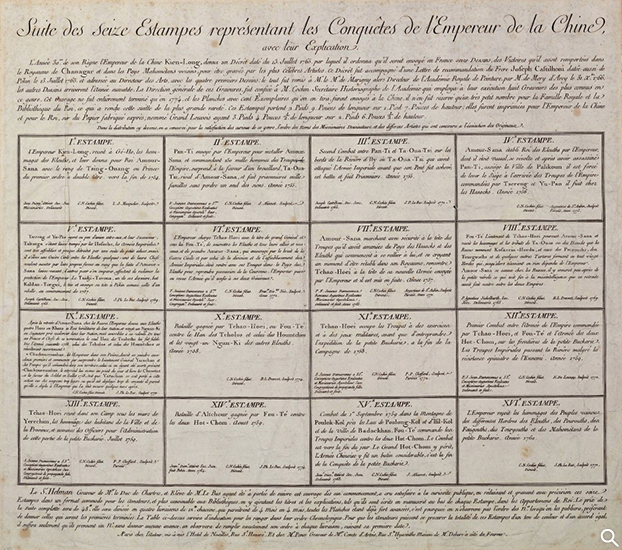Isidore-Stanislas Henri Helman (1743-1809) 38.9 cm × 44.1 cm Frame: 61.8 cm × 93.2 cm
The news that the copperplate engravings of the Victory in the Pacification of Dzungars and Muslims were to be produced in Paris immediately drew a lot of attention, and many people would like to get hold of the prints. Considering the significance of the commissioned project, the production team in Paris did not allow the prints to leak out. As Chinoiserie was becoming increasingly popular at the time, Isidore- Stanislas Henri Helman (1743-1809), a student of the engraver Jacques Philippe Le Bas, released in 1785 a series of smaller-sized versions of the copperplate engravings in 4 issues, each comprising 4 prints. The sketches that Giuseppe Castiglione and his associates made came with no textual description, and to his release of prints Helman added descriptive notes, entitling it “Suite des seize estampes représentant les Conquêtes de l’Empereur de la Chine, avec leur Explication (A Series of Sixteen Prints Representing the Conquest of the Emperor of China, with Explanations).” It is made up of three parts. The first addresses the production of copperplate engravings commissioned by the Qianlong emperor and France’s acceptance of the order. The second offers a description for each of the prints, along with the names of the illustrators and the engravers. The third is a note on Hellman’s release of the smaller-sized prints. Indeed, Hellman’s textual elaboration was the chief source of information for French men wishing to get to know the engravings. However, his ordering of the prints was somewhat erroneous. It was not until 1921 when Paul Pelliot (1878-1945) revealed, after detailed investigation and verification, the actual ordering in the journal T’oung Pao. Another attribute worth noting is that the “Suite des seize estampes représentant les Conquêtes de l’Empereur de la Chine, avec leur Explication” was printed on thin and light-weight paper and mounted on a backing paper, which carries the watermark of a British paper maker, “J. WHATMAN 1821,” round the lower-right corner. (Zhou Wei-qiang)

